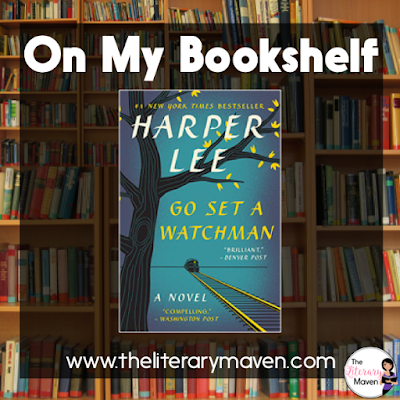Basic plot from Amazon: From Harper Lee comes a landmark new novel set two decades after her beloved Pulitzer Prize–winning masterpiece, To Kill a Mockingbird.
Maycomb, Alabama. Twenty-six-year-old Jean Louise Finch—"Scout"—returns home from New York City to visit her aging father, Atticus. Set against the backdrop of the civil rights tensions and political turmoil that were transforming the South, Jean Louise's homecoming turns bittersweet when she learns disturbing truths about her close-knit family, the town, and the people dearest to her. Memories from her childhood flood back, and her values and assumptions are thrown into doubt. Featuring many of the iconic characters from To Kill a Mockingbird, Go Set a Watchman perfectly captures a young woman, and a world, in painful yet necessary transition out of the illusions of the past—a journey that can only be guided by one's own conscience.
Written in the mid-1950s, Go Set a Watchman imparts a fuller, richer understanding and appreciation of Harper Lee. Here is an unforgettable novel of wisdom, humanity, passion, humor, and effortless precision—a profoundly affecting work of art that is both wonderfully evocative of another era and relevant to our own times. It not only confirms the enduring brilliance of To Kill a Mockingbird, but also serves as its essential companion, adding depth, context, and new meaning to an American classic.
Why I liked it: The flashbacks in Go Set a Watchman, the scenes from Scout’s childhood, were to me the best parts. Reading about Scout, Jem, and Dill as children was like getting to see old friends again. These scenes were warm and the characters full of life. In contrast, the scenes set in Jean Louise’s present seemed like a vocabulary exercise and the characters distant. The ending of the novel came all too soon. While Atticus congratulated Jean Louise for finally standing up to him, she quickly reconciles with him and I wanted to read more about where their relationship would go from there.
Classroom application: If you choose to have students read the novel as a whole, have them view this novel as a first draft and take on the role of Harper Lee’s editor. Ask them to advise Lee on what aspects of the novel work best and what she should focus her second draft. You can then have them read To Kill A Mockingbird, her “second draft,” to see if she followed their recommendations.
Maycomb, Alabama. Twenty-six-year-old Jean Louise Finch—"Scout"—returns home from New York City to visit her aging father, Atticus. Set against the backdrop of the civil rights tensions and political turmoil that were transforming the South, Jean Louise's homecoming turns bittersweet when she learns disturbing truths about her close-knit family, the town, and the people dearest to her. Memories from her childhood flood back, and her values and assumptions are thrown into doubt. Featuring many of the iconic characters from To Kill a Mockingbird, Go Set a Watchman perfectly captures a young woman, and a world, in painful yet necessary transition out of the illusions of the past—a journey that can only be guided by one's own conscience.
Written in the mid-1950s, Go Set a Watchman imparts a fuller, richer understanding and appreciation of Harper Lee. Here is an unforgettable novel of wisdom, humanity, passion, humor, and effortless precision—a profoundly affecting work of art that is both wonderfully evocative of another era and relevant to our own times. It not only confirms the enduring brilliance of To Kill a Mockingbird, but also serves as its essential companion, adding depth, context, and new meaning to an American classic.
Why I liked it: The flashbacks in Go Set a Watchman, the scenes from Scout’s childhood, were to me the best parts. Reading about Scout, Jem, and Dill as children was like getting to see old friends again. These scenes were warm and the characters full of life. In contrast, the scenes set in Jean Louise’s present seemed like a vocabulary exercise and the characters distant. The ending of the novel came all too soon. While Atticus congratulated Jean Louise for finally standing up to him, she quickly reconciles with him and I wanted to read more about where their relationship would go from there.
Classroom application: If you choose to have students read the novel as a whole, have them view this novel as a first draft and take on the role of Harper Lee’s editor. Ask them to advise Lee on what aspects of the novel work best and what she should focus her second draft. You can then have them read To Kill A Mockingbird, her “second draft,” to see if she followed their recommendations.
You could also introduce students to the theories that Go
Set A Watchman was not actually written by Harper Lee. After reading To Kill A
Mockingbird, provide students with excerpts of Go Set A Watchman and ask them
to evaluate the style of writing to see if it is consistent between the two
works.
If you are interested in purchasing a copy of Go Set A Watchman for yourself, you can find it on Amazon here.
Note: The Literary Maven is a participant in the Amazon Services LLC Associates Program, an affiliate advertising program designed to provide a means for sites to earn advertising fees by advertising and linking to amazon.com.




0 yorum:
Post a Comment